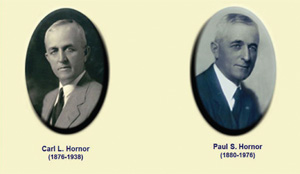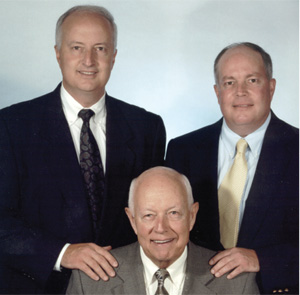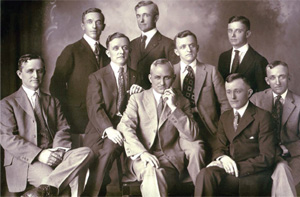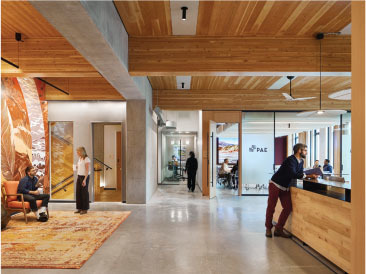September/October 2019
Communities: Private Practice
A West Virginia Engineering Legacy
 CARL L. HORNOR AND PAUL S. HORNOR
CARL L. HORNOR AND PAUL S. HORNORIn 1902, brothers Carl L. Hornor and Paul S. Hornor opened Hornor Brothers Engineers, centered in Clarksburg, West Virginia, a growing city fueled by glass and coal production. The firm was instrumental to the development of the city and north-central region of the state, providing surveying and engineering services for railroad, coal mine, and municipal projects.
Hornor Brothers Engineers continues to make its mark in Clarksburg and across the region. NSPE member Paul A. Hornor, III, P.E., P.S., and his brother John Hornor, P.S., represent the fourth generation of the family to lead the 117-year-old firm—the oldest in West Virginia. They are the great grandsons of Paul S. Hornor.
Today, HBE focuses on civil engineering, site design and development, municipal, water utilities, and gas well site development projects. The firm’s home has been in the same building since the late 1930s, in the heart of Clarksburg, near the Harrison County Courthouse and city hall.
Building Up a Community
 TREY HORNOR (LEFT), PAUL A. HORNOR, JR. (SEATED), AND JOHN HORNOR (RIGHT)
TREY HORNOR (LEFT), PAUL A. HORNOR, JR. (SEATED), AND JOHN HORNOR (RIGHT)Since its founding in 1902, Hornor Brothers Engineers has made its mark on Clarksburg and the local region. What was life like in Clarksburg at the time? In 1900, the first sewer lines were put into the city and in 1902 the first automobile made its way into the area. Access to natural resources and railroad facilities would attract industry and manufacturing to boost the city’s economic development (according to the city’s Wikipedia page). Soon there would be a thriving city with eight banks, three hospitals, and fine hotels. By 1929, the city had a population of more than 35,000.
The siblings contributed to the growth of the region with surveying and engineering projects involving railroads and coal mines and the development of residential districts.
The Hornor brother’s dedication to professionalism went beyond just the day-to-day engineering design projects. Carl Hornor was involved in the early days of NSPE and served as the West Virginia Society of Professional Engineers’ third president in 1934. His West Virginia licensure registration number was 43. Current HBE president Paul A. Hornor, III (who goes by the name “Trey”) holds West Virginia licensure registration number 10,281.
A Family Legacy
The significance of the firm to his family and the Clarksburg community was ingrained in Trey Hornor at an early age. His grandfather Paul Allen Hornor took over as the firm’s leader in 1938 until he retired in the early 1980s. His father (Paul A. Hornor Jr.) started his career at the company in 1963, when Hornor was a three-year-old, and became president in 1983. He recalls joining his father in the field on firm projects as a teenager, which helped him to appreciate design from a construction standpoint.
However, when Trey Hornor graduated from West Virginia University with a civil engineering degree in 1982, he wasn’t necessarily looking to start his career in the family business. “My thinking was that I would get a degree in a good field of study and see where that took me.”
The early years of Trey Hornor’s career took him around the world after accepting a position with the Chicago Bridge and Iron Company, a large construction and engineering company with projects in the US and internationally. For the first six months with the firm, he worked in the design department soon followed by two years on construction in South Africa. The last six months of his time with the company was spent in Houston. “I [realized] that with a big company it was going to be a process of moving around a lot as you progressed up through that company. After bouncing around for three years, I decided that this wasn’t what I wanted to do,” he says.
Back at home in Clarksburg, work was flowing for Hornor Brothers Engineers. In 1985, Paul A. Hornor Jr. reached out to his son. “He contacted me and said that if you ever thought that you wanted to come here and work, now would be a good time to consider doing that. And 34 years later, I’m still here,” he recalls with a laugh.
Trey Hornor worked his way up becoming principal and vice-president in 1989 and took over as president in 2001, following his father’s retirement.
Since the 1990s, the firm has concentrated on projects involving municipalities, water associations, and residential site development. The firm’s clients include the cities of Clarksburg, Bridgeport, Morgantown, West Union and Salem, the Adrian Public Service District, the United Hospital Center, and the North Central West Virginia Airport. Currently, this work is done with a staff of 10 employees, which includes two PEs and one EIT.
The United Hospital Center project in Bridgeport is an HBE staff favorite. The project featured a variety of civil design work, including large-scale earthwork and embankments, roads, parking areas, utilities, drainage, and retaining walls. “Most of these features are visible to all who visit the hospital campus,” says Trey Hornor. “We’re also pleased to have been a part of a project which so greatly benefits the health and well-being of the residents of north-central West Virginia.”
A Personal Touch
 1915 HORNOR BROTHERS FAMILY PHOTO: (SEATED FROM LEFT) CARL, RALPH, BOYD, LYLE, WAYNE, AND CHARLES. (STANDING FROM LEFT): FERDINAND, PAUL, AND J. LEE.
1915 HORNOR BROTHERS FAMILY PHOTO: (SEATED FROM LEFT) CARL, RALPH, BOYD, LYLE, WAYNE, AND CHARLES. (STANDING FROM LEFT): FERDINAND, PAUL, AND J. LEE.While there has been a trend in the AEC industry of larger firms acquiring family-owned and small engineering firms, HBE leadership is comfortable with staying small and local. “I do enjoy being my own boss. There’s a certain amount of pride about having your name on the business and the business having a long history,” says Trey Hornor.
“Smart growth” has come through a teaming partnership. In 2012, the firm entered into a partnership with Marshall Robinson, president of Allegheny Surveys Inc. The partnership was a win-win, as Hornor wanted to access opportunities for design work on oil and gas sites while Robinson needed access to engineering capabilities for projects.
What may distinguish HBE from larger AEC firms is the ability to offer a more personal touch. Most of the firm’s clients and projects aren’t far removed from Clarksburg and some client relationships have lasted as long as 40 years. Trey Hornor isn’t just an administrative figure head. He’s a working engineer who manages the business with a priority on ensuring client satisfaction. “It’s probably somewhat reassuring to clients that they are dealing with the guy whose name is on the business. That maybe isn’t the case at a larger firm.”
One of HBE’s longest clients has been the Adrian Public Service District (APSD). For more than 30 years, the firm has helped the APSD to expand water distribution into several rural counties. Seven projects have expanded service from zero customers to more than 2,000. Now an eighth, $9 million project is underway.
Nina Monroe, the former long-time general manager of the APSD, considers Trey Hornor to be “the face” of HBE. “He’s always been the one we worked with. He’s always so professional, totally prepared, and his team always got the job done,” she says.
Most of the APSD’s water system projects have been funded through the USDA Loan and Grant program. Accessing those funds is critical to its maintenance and expansion. The APSD is required by law to interview engineering firms for each new project, and larger firms do compete. Yet, the consistency of professionalism and qualifications makes HBE a strong contender. “When Trey Hornor completes an application for funding, it’s always complete the first time and it gets funded,” she says. “That’s one of the reasons that we stayed with Hornor Brothers project after project.”
Trey Hornor’s commitment to the community extends beyond just providing engineering and surveying services for local clients. He takes pride in being civic minded by serving on various boards and participating in community outreach. “The ownership and leadership of this firm has for many years relied on our faith in God to provide work and for wisdom in managing the business and our various projects. That’s been an important part of our success.”
-

THE ORIGINAL DOOR FROM THE OLD HORNOR BROTHERS BUILDING WAS MOVED TO THE CURRENT OFFICE BUILDING. THE DOOR SHOWS NAMES OF ALL THE HORNOR BROTHERS WHO WORKED AT VARIOUS BUSINESSES IN THE BUILDING. -

HORNOR BROTHERS ENGINEERS PROVIDED ENGINEERING SERVICES FOR THE CAMPUS AREA OF THE NEW UNITED HOSPITAL CENTER IN BRIDGEPORT, WEST VIRGINIA. -

THIS WALL SHOWCASES ALL OF THE PROFESSIONAL ENGINEERING LICENSES FOR THOSE WHO HAVE WORKED AT HORNOR BROTHERS ENGINEERS.
-

THE CURRENT HORNOR BROTHERS ENGINEERS OFFICE BUILDING -

THE OLD HORNOR BROTHERS ENGINEERS OFFICE BUILDING, CIRCA 1925 -

Hornor Brothers Engineers Projects Through the Decades
(based on information from the firm website)
1930s–1940s
The firm’s primary interest was in the coal mining industry. The demand for underground surveys and deep-mine design was particularly great during and after World War II. Hornor Brothers Engineers served hundreds of coal companies.
The firm became involved in water system development in the 1940s by first handling the project management responsibilities for construction of water treatment plants and storage reservoirs in the towns of Bridgeport and West Union.
1950s
HBE was involved in many municipal projects—streets, sidewalks, and most of the Benedum Airport facilities, including the terminal building and control tower.
1960s
The firm did a great deal of work for the City of Clarksburg, including the design of approximately 10 miles of concrete city streets.
1980s–1990s
HBE focused primarily on water system and sewer development, airport development and commercial and residential site development. Land surveying services also continued as they do today.


 Volunteering at NSPE is a great opportunity to grow your professional network and connect with other leaders in the field.
Volunteering at NSPE is a great opportunity to grow your professional network and connect with other leaders in the field. The National Society of Professional Engineers (NSPE) encourages you to explore the resources to cast your vote on election day:
The National Society of Professional Engineers (NSPE) encourages you to explore the resources to cast your vote on election day:






